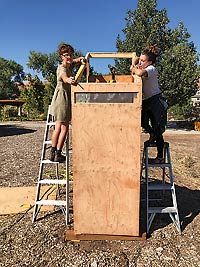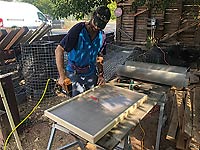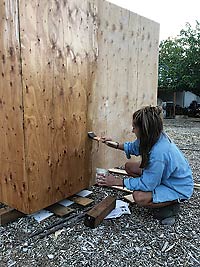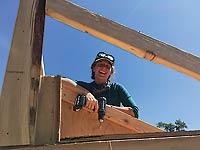SUSTAINABILITY HAPPENINGS October 2020 |
||||||||
| Well-Dressed: Exploring Fast Fashion and Textile Waste by Jessica Thacker |
||||||||
Don’t wear white after Labor Day. Pantone’s Color of the Year is Classic Blue No. 19-4052. Wearing Crocs is a major fashion faux pas. Fashion dictates the colors, styles, cuts, and patterns one wears which coincidentally displays our own unique personalities and lifestyles. The once four seasons of the major fashion houses (spring, summer, fall, and winter) have devolved into a flurry of weekly collections, hasty trends, and mass production. These days fashion is released in near real-time in an effort to keep consumers, well, consuming. All this fast fashion has a cost, but what is fast fashion? How does it affect us financially, emotionally, and environmentally and what can we do to offset the resulting textile waste?
Fast fashion is, by definition, inexpensive clothing produced rapidly by mass market retailers in response to the latest fashion trends. Through fast fashion, a viral street style can easily be marketed and sold in stores the following week. These items are produced with low-quality textiles and due to such rapid reproduction and demand, most items bypass any quality assurance and compliance checks. This results in paper thin garments with haphazard buttons, loose seams, and inconsistent sizing in shops. Fast fashion’s original intent was to make high fashion garments accessible to all budgets. As admirable as that intent may be, sometimes, it is possible to have too much of a good thing. The implications of this fast-paced and booming business model are dire—the emotional and financial strain of attempting to keep up with high turnover trends, the human-rights impact of sweatshop workers, and the dizzying amount of environmental waste. Let us focus particularly on the environmental aspect of fast fashion. Each step of clothing production has serious environmental ramifications from toxic chemicals, carbon emissions, and pollution of major water sources – specifically in third world countries where human labor is cheap and unregulated. According to the Environmental Protection Agency (EPA) Advancing Sustainable Materials Management 2017 report, roughly 6.3% of the total municipal solid waste generated in the United States was from textile waste. That is approximately 16.9 million tons of discarded clothing that entered the US’s landfills annually. According to the EPA Office of Solid Waste, Americans threw away more than 68 pounds of clothing and textiles per person each year and that figure is growing rapidly. With fast fashion’s reduced textile quality, the regular consumer purchases garments composed of plastic-based material such as polyester which releases microplastics into ocean waters or is left to slowly decay in a landfill when thrown out. The rapid consumption and contamination of precious water sources, quickly dyed with toxic and heavy metal based chemicals released as wastewater into local waterways, soil degradation and desertification from textile processing and cotton crop production, and the massive amount of fossil fuels used to produce and distribute these items all unnecessarily contribute to fast fashion’s environmental impact. Knowing this, how can we reduce our extravagant textile waste? First is a mantra that applies to many industries: buy local. Purchasing garments or other textile-based products reduces the shop to home journey which, in turn, reduces the consumer’s carbon footprint. Buying local products typically assumes handmade, high quality product guaranteeing the extended lifespan of the garment and reduces its potential to end up in a landfill. Another option is learning basic sewing skills. By gaining a general understanding of how to fix minor issues such as patching a hole or re-attaching a button, the lifespan of a textile is extended again and remains out of solid waste facilities. Another popular choice is donation. Through thrift stores and secondhand consignment shops, textiles have a second chance of possibilities. Luckily, Moab is home to two such options: the WabiSabi Community Thrift Store (located on 100 East 100 South) and the Remnant Vintage Thrift Store (located on 350 N 500 W). By both utilizing and frequenting thrift stores, the negative environmental effects can be reduced, and textiles reused and recycled. A final solution is the repurposing of old textiles. By giving textiles a secondary purpose, another pathway to environmental sustainability is discovered. Certain textiles, such as old t-shirts, can be repurposed into cleaning rags for the house or used as fabric for a homemade blanket. Many textiles have the capacity to be transformed into something else – all you need is a little research and good old-fashioned manual labor. Many consumers have the ability to reduce their textile waste and associated environmental impacts by shopping local and purchasing high-quality materials, supporting community thrift and consignment shops through donations and purchases, and learning to repurpose their existing textiles. By employing these methods, the harmful environmental cycle of fast fashion can be greatly reduced and our planet well-dressed in unpolluted waters, fertile soil, and fresh air. |
||||||||
| Serendipitous Sustainability by Rosemarie Russo |
||||||||
As fate would have it, as I pack up to leave Moab the groundbreaking roadmap report: Charting a Path for a Reliable, Resilient and Affordable Clean Energy was released. The Roadmap is the culmination of three years of the research project: “Renewable Energy Impacts and Solutions in Utah”. The project funded entirely by the National Renewable Energy Lab is one of many sustainability projects funded at no cost to taxpayers through grant funds garnered by the former Sustainability Department. Other grants included: • Solar Arrays (Water Reclamation & Golf Course) - $900,000 value, Funded by Rocky Mountain Power • Watt Smart (Energy Report & Charrettes) - $30,000, Brendle Consulting, Funded by Rocky Mountain Power • Solar Energy Innovation Network (SEIN): Roadmap and Modeling for Utah Team: Moab, SLC and Park City) - $90,000, Department of Energy • Clean Air Grant - $11,000, State of Utah • Electric Vehicle (EV) Charging Station Grant - $50,000, Department of Energy • Private donations to Sustainability Office - $16,000 • Old City Park Restoration and Access Grant - $40,000, State of Utah SEIN is an innovative program design that brings together teams of stakeholders from across the United States—including utilities, state and local governments, nonprofits, innovative companies, and electric system operators. Moab was one of nine teams selected from across the nation to work with technical experts from national laboratories and other research institutions to implement innovative applications of solar and distributed energy. The teams made rapid progress toward multi-technology solutions such as the pairing of PV and EVs. The city’s project again funded by outside sources was the installation of one of the dozens of EV charging stations at Adventure Inn, a Green to Gold business park. Vehicles using that station are fueling from the sun. The Old City Park grant funded an electric golf cart that can used rather than old city diesel trucks. The team was led by Kate Bowen and Sarah Wright of Utah Clean Energy and included the Sustainability Directors from Park City, Moab and Salt Lake City. The Utah Team worked with Rocky Mountain Power as well to facilitate low cost solar energy. The goal was to evaluate the potential of distributed energy resources (i.e., energy efficiency, demand flexibility: when you use energy, beneficial electrification – pairing solar in day and using storage at night via a battery in your EV) and different scales of solar (ground mount, roof mount, community scale and utility scale) in support of the respective communities Renewable Energy, Transportation, Clean Air and Carbon Goals.  The Roadmap provides a triple bottom line analysis of actions that can be taken at a homeowners or developers level. It could be used to update building permits that align with clean air initiatives by identifying recommending, requiring and/or subsidizing less polluting heat and cooling technologies. Figures 12 and 14 outline how technologies can be combined to optimize savings and the least expenses technologies that households can use to lower utility bills. Spoiler alert – the top three solutions modeled are: high efficiency heat pumps; drill and fill cavity insulation and regular insulation. Plus, Rocky Mountain Power provide multiple rebates for insulation purchases. Chapter 5 of the Roadmap outlines strategies along with technical and legal resources for the community at large. Several of the strategies were adapted from Moab’s Sustainability Action Plan. As we recover from CO-VID, implementing cost effective, clean energy actions throughout the community will benefit us, the ecosystem and future generations. The Roadmap provides a triple bottom line analysis of actions that can be taken at a homeowners or developers level. It could be used to update building permits that align with clean air initiatives by identifying recommending, requiring and/or subsidizing less polluting heat and cooling technologies. Figures 12 and 14 outline how technologies can be combined to optimize savings and the least expenses technologies that households can use to lower utility bills. Spoiler alert – the top three solutions modeled are: high efficiency heat pumps; drill and fill cavity insulation and regular insulation. Plus, Rocky Mountain Power provide multiple rebates for insulation purchases. Chapter 5 of the Roadmap outlines strategies along with technical and legal resources for the community at large. Several of the strategies were adapted from Moab’s Sustainability Action Plan. As we recover from CO-VID, implementing cost effective, clean energy actions throughout the community will benefit us, the ecosystem and future generations.Stay Well. A copy of the Roadmap is available at USU or @ utahcleanenergy.com. For additional information about the report, please contact Kate Bowen. kbowen@utahcleanenergy.com. References: Community Renewable Energy Act, H.B. 411 (2019). https://le.utah.gov/~2019/bills/static/HB0411.html |
||||||||
| Community Solar Dehydrator Project Completed & Ready for Use by Kate Weigel and Roslynn McCann |
||||||||
The project was led by UCC AmeriCorps member Kate Weigel, who is currently serving for a year with the Utah State University Extension Permaculture Initiative. Weigel modified open-source plans from Little Colorado River Plateau Resource Conservation and Development Area for the design of the project. Shingles were donated by local Sommer Stewart, with other in-kind donations from Walker True Value Hardware and the USU Permaculture Initiative. Thank you so much to all the folks who made this possible, including volunteers Luke Kantola, Will Kershner, Charlotte Van Voast, Eilise Gancarz-Davies, Eddie Lovell, Veronica Verdin, Pat Dawson, Joe Bondi, a
To use the dehydrator, contact Emily Roberson at community@youthgardenproject.org, and you will be added to the calendar. The cost
We look forward to seeing you at YGP, and here’s to a more self-sufficient community! |




